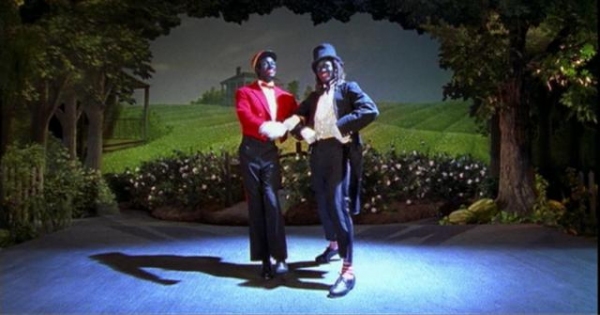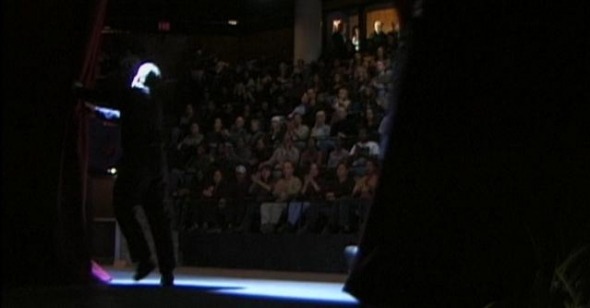Rebirth of a Nation
Michael Koresky on Bamboozled
With Bamboozled, Spike Lee entered the new millennium and announced, without the slightest hesitation, that filmmaking was still a primitive medium. Technologically and educationally unformed—made suspect and misshapen by those who wielded it, and barely ready to be vindicated. The form itself was disintegrating before our eyes, slowly, steadily being replaced—but by equally muddied pixels. By the year 2000, the digital revolution still seemed ill-equipped to replicate the luxe of celluloid that had at once captured Spike Lee’s imagination and catalogued the century’s worth of negative images, stereotypes, and horrors he was rebelling against. Film, difficult and arduous to create, unspools smooth and richly toned; video, wielded with abandon and ease, projects with flat clarity and thinness. Yet while video can be repeated infinitely without degradation, aged films increasingly seem like dispatches from a long-ago planet.
Rising from this primordial muck is Bamboozled, wholly concerned with the mightily disparate properties of film and video, and the necessity of erecting a new film language in place of a fatigued old one. In his film, the image distorts, in increasingly unpleasant, necessary ways—and so do words. Spike Lee has always been terribly mindful of the evil that language can do, the nightmare of postmodern doublespeak, the sudden turn of phrase that can betray an entire people, the possibility for self-negation inherent in all dialogue. If our current dictionary needs to be rebuked then perhaps the language of film itself isn’t far behind, as entrenched as it is in outmoded codes and misconceptions.
What better way to start such a missive than with a definition straight from Noah Webster himself, delivered directly to the camera with the utterly intimidating precision, discomfiting accent, and intonations of Damon Wayans’s dubious TV executive Pierre Delacroix? Yet even before Wayans audaciously pronounces the word and meaning of “satire,” the first official scripted words of Bamboozled, Spike Lee serves up something else. “In 1492, you came upon these shores,” sings Stevie Wonder, accompanied by the sounds of creaking waves and a ramshackle old harpsichord. “Seven-hundred years, educated by the moors.” Written for the film, Wonder’s “Misrepresented People” sets the stage, its sounds evoking both Columbus’s arrival and, by inference and a later verse, the Middle Passage. Wayans has yet to recite from Webster as he wags his mannered fingers to the camera (in a performance that’s been praised for its exquisite creepiness less often than it’s been criticized for its overt stylization), but already we’ve been privy to a clear definition—low grade, blotchy. The sounds of Wonder’s creaking ship are accompanied by the vertiginous tilt of the camera as it circles around Delacroix’s Brooklyn loft, opening on an enormous clock-window that might as well be looking out over an ocean; this new form of cinema brings about instant seasickness.
Bamboozled unfolds with a jaundiced pallor, oddly rhythmic in Sam Pollard’s jarring editing choices and given the strange whim of cinematographer Ellen Kuras’s seemingly slovenly camera placement and shifting lenses. Immediately following the opening sequence, Pierre embarks down a city street curved by a fish-eye lens; not only does the cityscape seem tortured and bent, the quality of the video gives it the free-floating distortion of an aquarium—New York underwater. The entire film feels this distorted, as ruled by the technical byproducts of its creations, its own digital pops and crackles, as any other stylistic or narrative choice. High angles flatten and obscure heads and figures, low angles demonize; Wayans’s fingers, used alternately as weapons of condescension and extensions of false deference (watch how he enunciates the words “we have three-dimensional characters” during his initial pitch meeting with his cowed, curled knuckles) seem mottled and elongated. When sun shines into any given scene, it provides not illumination, but a harsh glare; and the camera could be anywhere at any time, perched from any odd angle, to bear witness to this just slightly tweaked dystopia.
This was 2000; more and more digitally shot narrative features were seeing the inside of a movie theater, almost exclusively transferred onto film, which added an extra layer of removal and a further sheen of unreality. Just seven years ago, digital video seemed exclusively the domain of the independent filmmaker—either the not-ready-for-prime-time players who needed a cheap training ground (Miguel Arteta’s Chuck & Buck, Marc Forster’s Everything Put Together) or the journeymen looking for new ways to fund and shoot their wildly varying oeuvres (Mike Figgis’s Time Code, Lars von Trier’s Dancer in the Dark). Both approaches were slowly bringing video into mainstream acceptance while also consigning it to a realm resolutely outside of studio polish; and with hi-def a crystalline glint in Hollywood’s eye, Spike Lee’s announcement that he would be directing his next narrative studio film (after 1999’s scattershot Summer of Sam) on video came as something of a surprise. Yet with Time-Warner’s New Line Cinema unlikely to put their hearts, souls, and cash behind a film that meant to call out the rancid stereotyping of African-Americans, past, present, and (gulp) future, Lee knew he would benefit from the handicam’s cheapness and mobility, as well as the techniques of AVID editing, which would allow him to cut more often (a definite contributing factor to the film’s disorienting freefall of strange camera positions and angles).
It would be too simple and clichéd to say that Spike Lee was on the cutting edge; by all accounts Bamboozled seems to have been shot in its fashion out of necessity. Yet rarely has Lee’s aesthetic been so accurately, spiritually wedded to his ideology—the erratic sound mix, the inconsistent lighting, the sense of multiple cameras jostling for screen supremacy (often Kuras set up more than ten cameras within scenes to capture moments when the actors would least expect it; the effect is not flattering to them) all fruitfully aid this tale of woe and compromise. Bamboozled, in which Delacroix pitches an idea for a modern-day minstrel show to his racist network TV boss, Dunwitty, in the hopes that it will get him fired, only to find the country, and himself, seduced by the images of black-face and buffoonery, transplants Mel Brooks/Paddy Chayefsky–derived notions of American hucksterism and dwindled values in entertainment media to a new stage. And like a tool of surveillance, Spike Lee’s dirty little camera captures it all for posterity.
The use of digital video for Bamboozled was almost epiphanic; Spike Lee was intuitively finding new ways to represent what film had failed at for so long. Bamboozled is barely a comedy, as “funny as a dead baby,” to quote the dimwitted Dunwitty, and it’s also barely a film. How can a medium as compromised as film possibly contain Spike Lee’s revisionist rage? Almost in response, he decided to shoot the centerpiece scenes of “Mantan: The New Millennium Minstrel Show” on 16mm film, thus creating a defiant split (emotional as well as technical) between celluloid and video, then and now. The scenes shot on film are lush, seductive, eye-popping in primary colors—ostensibly viewed from the head-on point of view of the studio audience, another irony considering tape is used to record most live sitcoms. Just as suddenly vivid are the spirited hi-jinks of Savion Glover and Tommy Davidson as “Mantan” and “Sleep’n eat,” “two real coons,” outfitted in fire engine–colored lipstick, layers of dark burnt cork, and, respectively, a tattered old suit and a blazing red lawn-jockey coat.
With its strain of Amos ‘n Andy camaraderie, “The New Millennium Minstrel Show” is outmoded but frighteningly timeless, and it’s not difficult to see how its humor can go down so easily for an insensate public. It’s a language of buffoonery with which we’re all too familiar, dredging up not just the Jim Crow entertainment of choice, but an entire century’s worth of preferred address; the unspoken mother tongue of bug-eyes, jutted lips, and carefree dancin’ fools. Basically, it’s refreshing in its nostalgia, reassuring in its subjugation, soothing in its repetition.
And this is the key to Bamboozled: “same shit done over,” as Davidson says late in the film before quitting the sinking ship that “Mantan” becomes. Images seen for a hundred years repeated again and again, whether blatantly or hidden within conventions (Lee makes the case, fairly directly, that such ideas are reappropriated and furthered in shows like Good Times and in the public deference of actors such as Cuba Gooding Jr. and Ving Rhames). Words lose their meaning in addled recurrence, and Lee cites the bastardization of language as the road to chaos. Early in the film, the appropriately angry but frustratingly misguided radical hip-hop group, the Mau Maus, led by Mos Def’s Big Blak Afrika (né Julius Hopkins), collectively decide to respell the word “black” as “b-l-a-k,” to get an upper hand on that “old slave-owner Noah Webster.” Mau Mau member Smooth (Charli Baltimore) professes: “I don’t even know why they put the “c” in there to begin with.” Yet with their increasingly hostile temperament, and their final, sorrowful decision to fight hate with murder, the Mau Maus have destroyed life, rather than simply revising the English language itself. The Mau Maus bring revolution not with words, but like Delacroix himself, with weapons.
In one pointed moment, Lee cuts a discussion amongst the Mau Maus into a rapid-fire showcase of their sound and fury, signifying nothing: “Know what I’m sayin’?” “Know what I mean?” is repeated ad nauseam, in circular fashion. Basically, we do not finally know what they’re saying, and neither do they. Bluster and rage replaces reason, and Lee’s decision to double back and repeat their words only further dulls their point. Their revolution ultimately fails, devolving into a nonsensical bloodbath, created for public consumption.
Spike Lee doesn’t make the same mistakes as the Mau Maus in his attempts to tear down an old language and replace it with a new one. He’s not simply omitting the letter “c,” but rather trying something truly regenerative. The most expansive, cathartic cut in Bamboozled is probably that initial transition from the sawdust rut of video to the splendid colors of celluloid. Compared to the nascent technology of ones and zeroes, the 16mm film looks effortless, magical, like unearthed, preserved Technicolor. Here is all that the film is, rails against, gussied up in its Sunday best, deceiving us once more. The dialogue fostered between the two mediums finds its unholiest representation in the character of “Honeycut,” “Mantan”’s emcee, picked from a paltry pool of talent during auditions, barely able to remember his prepared Shakespeare monologues (“To be or not to be…that’s the motherfuckin’ question”) and more than happy to recite any racist screed for a grand corporate paycheck. Hired essentially to prime the viewers pre-show, Honeycut enacts a call-and-response game with the live studio audience, calling “Oooooo-weeeeee!” before raising a hand to his ear and awaiting an enthusiastic “Ooooo-waaaaah!” It’s language boiled down to its most aggressively knee-jerk, an expression of a self-devouring system that thrives on thoughtless complicity.
In 2000, the independent ethos Lee carried over from his earlier days found its natural extension in video, the rawness of which is rapidly dwindling as the clarity and precision of the image grow sharper with each passing year. Whether or not this is the new language Lee was intending, we’re still a good twenty to thirty years away from the hundredth anniversary of the most recent footage in the film’s final, devastating ten-minute clip reel he compiled with editor Sam Pollard, a veritable treasure trove of thick-lipped pickaninnies, bucks, and Aunt Jemimas from early Hollywood, silent era and way beyond. Following the final broadcast of “Mantan,” this hellish montage is the next instance in Bamboozled in which we are presented with the texture of film—as both cultural artifact and unavoidable parallel of the here and now. Of course, Spike Lee knows celluloid is highly flammable, and given to easy decomposition.

